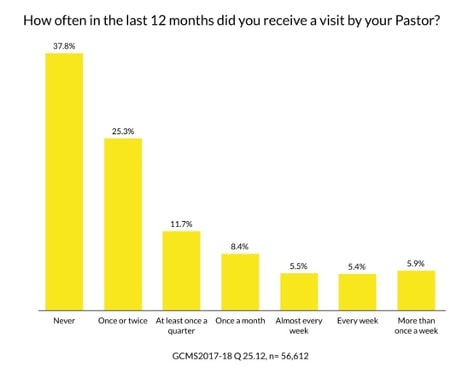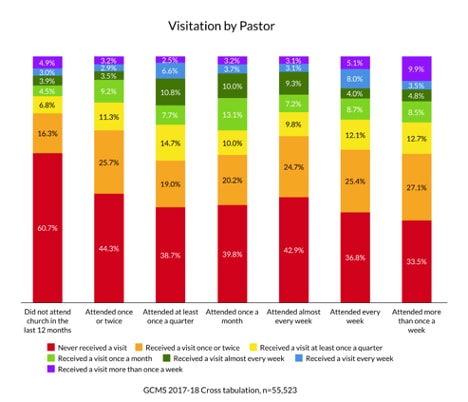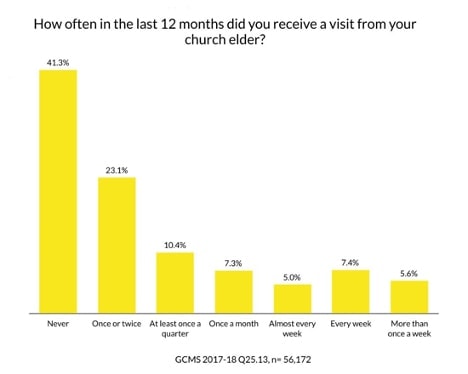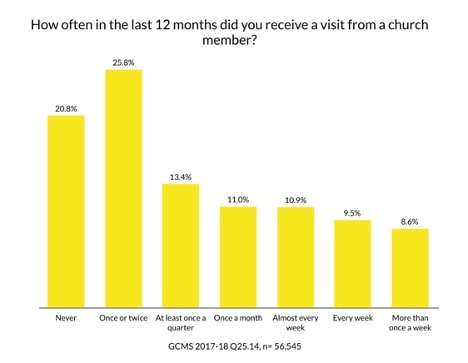
1
It was written about the early Christian believers: “They devoted themselves to the apostles’ teaching and to fellowship, to the breaking of bread and to prayer. Everyone was filled with awe at the many wonders and signs performed by the apostles. All the believers were together and had everything in common. . . . Every day they continued to meet together in the temple courts. They broke bread in their homes and ate together with glad and sincere hearts, praising God and enjoying the favor of all the people. And the Lord added to their number daily those who were being saved” (Acts 2:42–47).2
The Adventist Church uses Christ’s method to minister to those outside the church. But how good are we in ministering to our own members?
A Pastor’s Responsibility?
The Global Church Member Survey 2017-2018 (GCMS) asked members how often in the last 12 months they had received a visit from their pastor. The largest group of respondents (38 percent) reported that they had never received such a visit. Another quarter (25 percent) reported one or two pastoral visits in the last year. Twelve percent reported such a visit every quarter, and another 25 percent had received a pastor’s visit once a month or more often.

When the survey results were cross-tabulated, they showed that members who had not attended church in the last 12 months were least likely to receive pastoral visits. Members who attended church every week were most likely to receive frequent (weekly) visits from their pastor. These findings point to a lack of tender pastoral care of nonregular churchgoers.

Elder Interaction
Church members were also asked how often in the last year they had received a visit from a church elder. The results were similar to visits by a pastor. Two out of five (41 percent) respondents had never received a visit from an elder, while 23 percent reported an elder visiting once or twice in the last year. Ten percent reported that an elder had visited their home approximately once a quarter, and again, 25 percent had enjoyed visits from a church elder once a month or more often.

When the results were cross-tabulated, they revealed similar results to the frequency of pastoral visits. Those who had not attended church in the last 12 months were least likely to receive a visit from an elder, while members who attended church every week were most likely to receive such visits, specifically on a weekly basis.

These numbers are cause for concern. They reveal that church leaders do not appear to be reaching out to those who have stepped away from the church or are not regular attenders/regularly involved. It is vital that church leaders connect with all their members, especially those who are no longer active. After all, Jesus said,“It is not the healthy who need a doctor, but the sick: I have not come to call the righteous, but sinners” (Mark 2:17).
Our Duty to Each Other
How do members do when it comes to interacting with each other? Are they doing better about visiting each other, visiting more frequently than pastors and/or elders?
The number of those who had not received a visit from fellow church members in the last year was almost twice as low as those never having been visited by an elder (21 percent). Another quarter (26 percent) reported having received one or two such visits once or twice a year, and 13 percent had received a visit from a church member at least once a quarter in the last year. A large number (40 percent) had also received such visits once a month or more often.

When we examine the structure of the New Testament church and review the letters written by the apostles Peter, Paul, and John, we see again and again how important it is to be in Christian community with each other. We also see that there is great spiritual power when believers come together in the name of Christ.
Members who had not attended church in the last 12 months were again the least-visited category of members when the numbers were cross-tabulated. It appears that church members were also keen to engage in community with those who were actively involved, perhaps neglecting those who had fallen by the wayside or were outside the church’s four walls. It might also be that local churches do not have information about those who have stopped attending services.

Based on the results of the 2017-2018 GCMS, local church leaders should be challenged to be aware of what is happening in the lives of their members and visit them more frequently; similarly, church members should be challenged to visit and fellowship with each other more often.
While this may seem difficult to do during a global pandemic, it may be time to consider more creative ways of interacting. Scheduling a Zoom hangout, small-group meeting, or FaceTime call; getting together for a physically distanced picnic or chat; even sending handwritten notes can all be great ways to remind members that they are valued. Such interactions will likely result in bringing members back inside the four walls of the church when the pandemic has passed.
Jesus said, “A new command I give you: Love one another. As I have loved you, so you must love one another. By this everyone will know that you are my disciples, if you love one another”(John 13:34, 35). We demonstrate our love for one another when we create opportunities to intentionally interact with one another.
For more information on 2017-2018 Global Church Member Survey (GCMS), visit www.adventistresearch.org/blog/2020/09/global-trends-church-member-visitation.
1 Created in collaboration with the Institute of Church Ministry.
2 Bible texts are from the Holy Bible, New International Version. Copyright ã 1973, 1978, 1984, 2011 by Biblica, Inc. Used by permission. All rights reserved worldwide.